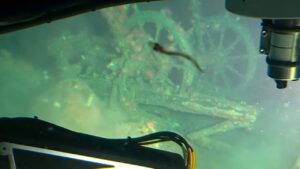A volcano erupting on a small island in the Sub Antarctic is depositing ash over one of the world’s largest penguin colonies.
6 July 2016 – British Antarctic Survey Press Office
Zavodovski Island is a small island in the South Sandwich archipelago and its volcano Mt Curry has been erupting since March 2016. The island is home to over one million chinstrap penguins – the largest colony for this species in the world.
The island is part of the British Overseas Territory of South Georgia & the South Sandwich Islands and uninhabited. British Antarctic Survey (BAS) recently remapped this chain of volcanic islands and was alerted to a large (7.2) magnitude earthquake last month in the vicinity. Researchers confirmed from satellite imagery that not one, but two volcanoes are erupting in the South Sandwich Islands. Mt Curry on Zavodovski Island to the north of the archipelago and Mt Sourabaya on Bristol Island to the south.
Following the earthquake, fishing vessels in the area licenced by the Government of South Georgia & the South Sandwich Islands, captured photos of the Zavodovski Island eruption. They show the main volcanic vent is on the western side of the island, but the prevailing wind is blowing the smoke and ash to the east, and depositing much of it on the lower slopes of the volcano. These are home to the chinstraps, closely packed in great numbers. In addition there are around 180,000 macaroni penguins.
Satellite images have confirmed that between one third and one half of the island has so far been covered in ash. At the time photos were taken, the adult chinstraps were moulting, shedding their old feathers for new ones and therefore unable to leave the island.
Geographer Dr Peter Fretwell from BAS who was involved in the remapping of the archipelago says:
“We don’t know what impact the ash will have on the penguins. If it has been heavy and widespread it may have a serious effect on the population. It’s impossible to say but two scientific expeditions are scheduled to visit the region from later this year and will try to assess the impact of the eruption.”
Penguin ecologist Mike Dunn from BAS says:
“As the images were captured during the moult period for the chinstraps, the consequences could be very significant. When the penguins return to breed later in the year, it will be interesting to see what impact this event has on their numbers.”
Ends
Zavodovski Island is the most northerly of the South Sandwich Islands, a remote uninhabited archipelago of islands in the Sub Antarctic. There are eleven islands in the group all of which are of volcanic origin. The South Sandwich Islands form part of South Georgia & the South Sandwich Islands, a UK overseas territory. The South Sandwich Islands are the emergent parts of volcanoes forming the volcanic arc of a subduction system. This subduction system is a tectonically active part of the Scotia Sea, a compact ocean gateway region of global significance for interactions between tectonics, oceanographic flow, climate and biodiversity during Cenozoic to recent times. This is the first time that Zavodovski Island has been witnessed erupting, although there is evidence that it erupted in the 1970s, possibly in the 1980s and as late as 2012, although the nature of those eruptions is unknown.
Zavodovski Island is named after the second in command of the expedition led by the Russian explorer Bellingshausen in 1820 who first sighted the island. It is located around 300 kms north of Bristol Island.
The Government of South Georgia & the South Sandwich Islands manages a sustainable fishery around the South Sandwich Islands.
Chinstrap penguins (Pygoscelis Antarctica) are one of the brush-tailed penguin species common around the Antarctic Peninsula and Scotia Sea. The global adult population of Chinstraps was estimated at over seven million pairs in 2013.
Zavodovski Island contains around 1.2 million adults. It is one of the world’s largest colonies of penguins and the largest chinstrap penguin colony. The colony stretches around the Asphyxia Plain on the flatter land on the east south and north of the island. The penguins are named for the distinctive strap under their beaks. Their bodies are around 70cm long and stand around 50cm high.
British Antarctic Survey (BAS), an institute of the Natural Environment Research Council (NERC), delivers and enables world-leading interdisciplinary research in the Polar Regions. Its skilled science and support staff based in Cambridge, Antarctica and the Arctic, work together to deliver research that uses the Polar Regions to advance our understanding of Earth as a sustainable planet. Through its extensive logistic capability and know-how BAS facilitates access for the British, European and international science community to the UK polar research operation. Numerous national and international collaborations, combined with an excellent infrastructure help sustain a world leading position for the UK in Antarctic affairs. For more information visit www.bas.ac.uk
South Georgia & the South Sandwich Islands (SGSSI) is a UK Overseas Territory situated 1,450 km south-east of the Falkland Islands. The South Sandwich Islands are a chain of eleven small volcanic islands, 550 km to the south-east of South Georgia, extending to nearly 60°S. SGSSI is administered by a small Government in Stanley in the Falkland Islands, with representatives at King Edward Point on South Georgia. SGSSI is home to globally significant populations of seabirds and marine mammals. The Government recently launched its five-year Strategy 2016–2020 which sets out it headline objective of world-class environmental management underpinned by the highest standards of governance. For more information visit www.gov.gs
#antarctica #penguins





